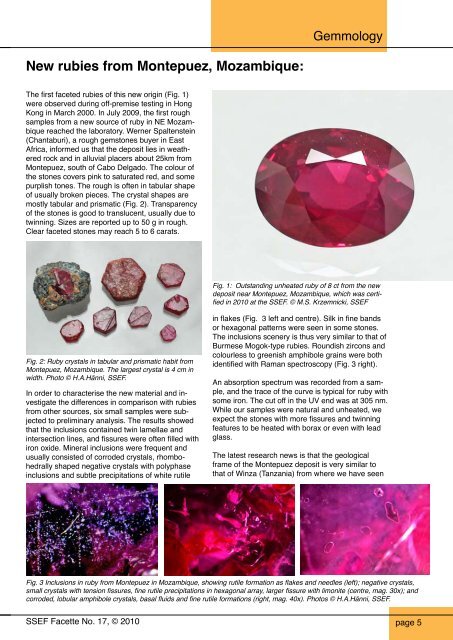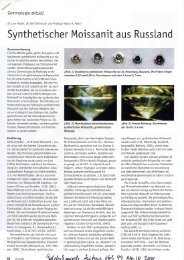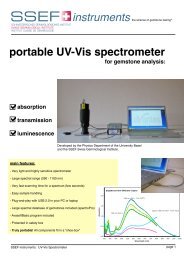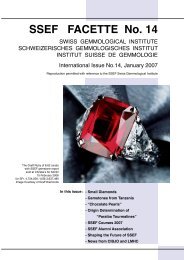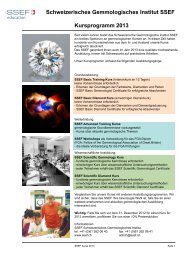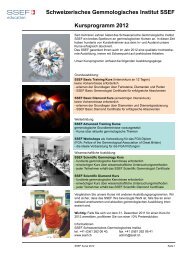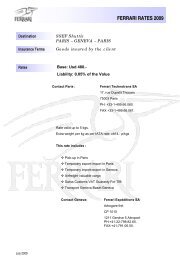SSEF FACETTE No. 17
SSEF FACETTE No. 17
SSEF FACETTE No. 17
You also want an ePaper? Increase the reach of your titles
YUMPU automatically turns print PDFs into web optimized ePapers that Google loves.
New rubies from Montepuez, Mozambique:<br />
The first faceted rubies of this new origin (Fig. 1)<br />
were observed during off-premise testing in Hong<br />
Kong in March 2000. In July 2009, the first rough<br />
samples from a new source of ruby in NE Mozambique<br />
reached the laboratory. Werner Spaltenstein<br />
(Chantaburi), a rough gemstones buyer in East<br />
Africa, informed us that the deposit lies in weathered<br />
rock and in alluvial placers about 25km from<br />
Montepuez, south of Cabo Delgado. The colour of<br />
the stones covers pink to saturated red, and some<br />
purplish tones. The rough is often in tabular shape<br />
of usually broken pieces. The crystal shapes are<br />
mostly tabular and prismatic (Fig. 2). Transparency<br />
of the stones is good to translucent, usually due to<br />
twinning. Sizes are reported up to 50 g in rough.<br />
Clear faceted stones may reach 5 to 6 carats.<br />
Fig. 2: Ruby crystals in tabular and prismatic habit from<br />
Montepuez, Mozambique. The largest crystal is 4 cm in<br />
width. Photo © H.A.Hänni, <strong>SSEF</strong>.<br />
In order to characterise the new material and investigate<br />
the differences in comparison with rubies<br />
from other sources, six small samples were subjected<br />
to preliminary analysis. The results showed<br />
that the inclusions contained twin lamellae and<br />
intersection lines, and fissures were often filled with<br />
iron oxide. Mineral inclusions were frequent and<br />
usually consisted of corroded crystals, rhombohedrally<br />
shaped negative crystals with polyphase<br />
inclusions and subtle precipitations of white rutile<br />
<strong>SSEF</strong> Facette <strong>No</strong>. <strong>17</strong>, © 2010<br />
Gemmology<br />
Fig. 1: Outstanding unheated ruby of 8 ct from the new<br />
deposit near Montepuez, Mozambique, which was certified<br />
in 2010 at the <strong>SSEF</strong>. © M.S. Krzemnicki, <strong>SSEF</strong><br />
in flakes (Fig. 3 left and centre). Silk in fine bands<br />
or hexagonal patterns were seen in some stones.<br />
The inclusions scenery is thus very similar to that of<br />
Burmese Mogok-type rubies. Roundish zircons and<br />
colourless to greenish amphibole grains were both<br />
identified with Raman spectroscopy (Fig. 3 right).<br />
An absorption spectrum was recorded from a sample,<br />
and the trace of the curve is typical for ruby with<br />
some iron. The cut off in the UV end was at 305 nm.<br />
While our samples were natural and unheated, we<br />
expect the stones with more fissures and twinning<br />
features to be heated with borax or even with lead<br />
glass.<br />
The latest research news is that the geological<br />
frame of the Montepuez deposit is very similar to<br />
that of Winza (Tanzania) from where we have seen<br />
Fig. 3 Inclusions in ruby from Montepuez in Mozambique, showing rutile formation as flakes and needles (left); negative crystals,<br />
small crystals with tension fissures, fine rutile precipitations in hexagonal array, larger fissure with limonite (centre, mag. 30x); and<br />
corroded, lobular amphibole crystals, basal fluids and fine rutile formations (right, mag. 40x). Photos © H.A.Hänni, <strong>SSEF</strong>.<br />
page 5


